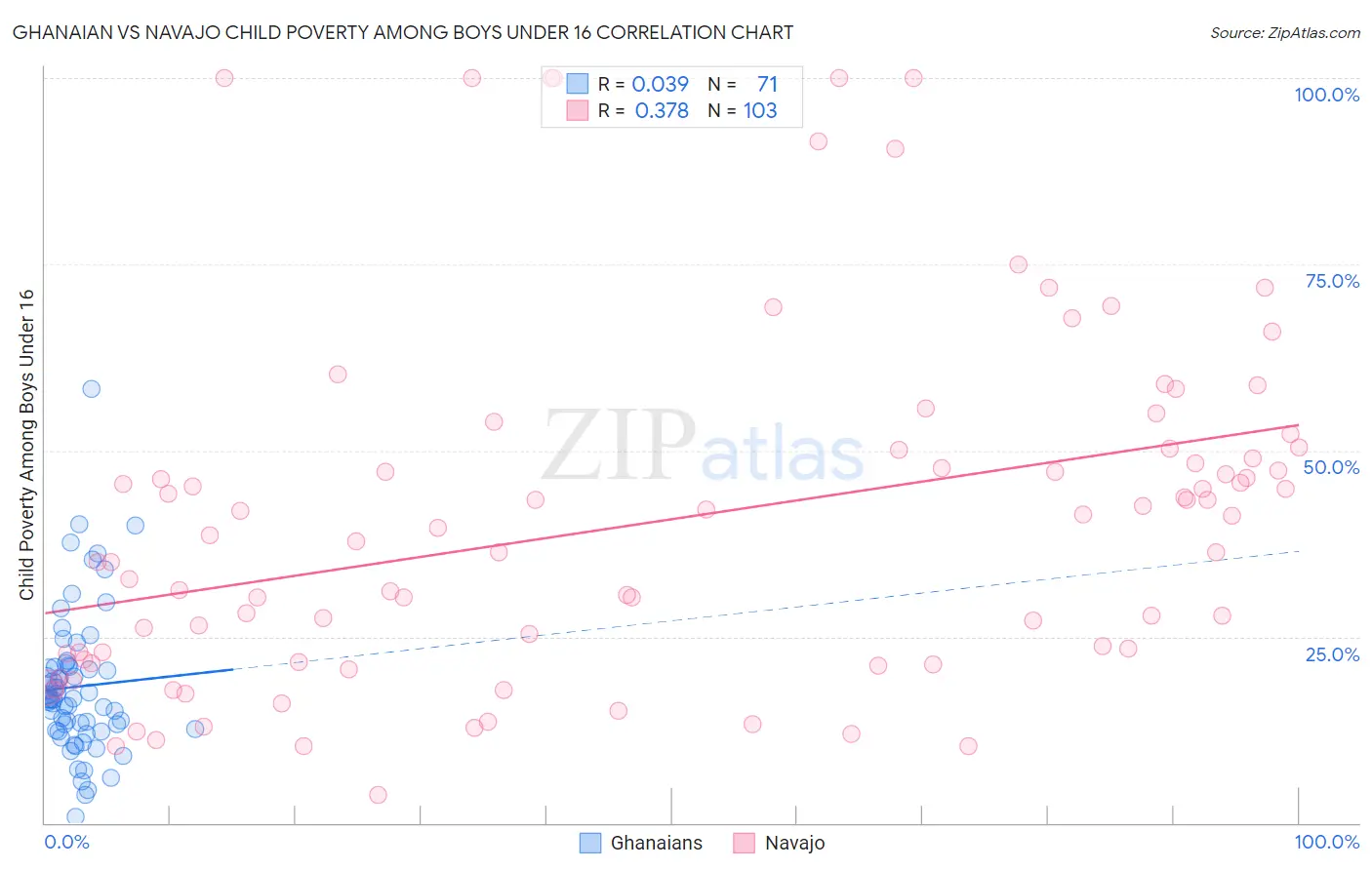Ghanaian vs Navajo Child Poverty Among Boys Under 16
COMPARE
Ghanaian
Navajo
Child Poverty Among Boys Under 16
Child Poverty Among Boys Under 16 Comparison
Ghanaians
Navajo
18.9%
CHILD POVERTY AMONG BOYS UNDER 16
0.5/ 100
METRIC RATING
242nd/ 347
METRIC RANK
30.3%
CHILD POVERTY AMONG BOYS UNDER 16
0.0/ 100
METRIC RATING
343rd/ 347
METRIC RANK
Ghanaian vs Navajo Child Poverty Among Boys Under 16 Correlation Chart
The statistical analysis conducted on geographies consisting of 189,368,520 people shows no correlation between the proportion of Ghanaians and poverty level among boys under the age of 16 in the United States with a correlation coefficient (R) of 0.039 and weighted average of 18.9%. Similarly, the statistical analysis conducted on geographies consisting of 223,444,505 people shows a mild positive correlation between the proportion of Navajo and poverty level among boys under the age of 16 in the United States with a correlation coefficient (R) of 0.378 and weighted average of 30.3%, a difference of 60.4%.

Child Poverty Among Boys Under 16 Correlation Summary
| Measurement | Ghanaian | Navajo |
| Minimum | 0.79% | 3.7% |
| Maximum | 58.3% | 100.0% |
| Range | 57.5% | 96.3% |
| Mean | 18.3% | 40.5% |
| Median | 16.6% | 38.7% |
| Interquartile 25% (IQ1) | 12.4% | 22.0% |
| Interquartile 75% (IQ3) | 21.0% | 50.2% |
| Interquartile Range (IQR) | 8.6% | 28.1% |
| Standard Deviation (Sample) | 9.7% | 23.4% |
| Standard Deviation (Population) | 9.6% | 23.3% |
Similar Demographics by Child Poverty Among Boys Under 16
Demographics Similar to Ghanaians by Child Poverty Among Boys Under 16
In terms of child poverty among boys under 16, the demographic groups most similar to Ghanaians are Immigrants from the Azores (18.9%, a difference of 0.34%), Immigrants from Middle Africa (18.9%, a difference of 0.35%), Cree (19.0%, a difference of 0.48%), Immigrants from Sudan (18.8%, a difference of 0.50%), and Immigrants from Cuba (18.8%, a difference of 0.56%).
| Demographics | Rating | Rank | Child Poverty Among Boys Under 16 |
| Americans | 0.9 /100 | #235 | Tragic 18.6% |
| Sudanese | 0.9 /100 | #236 | Tragic 18.6% |
| Immigrants | Eritrea | 0.8 /100 | #237 | Tragic 18.6% |
| Immigrants | Laos | 0.8 /100 | #238 | Tragic 18.7% |
| Cape Verdeans | 0.7 /100 | #239 | Tragic 18.7% |
| Immigrants | Cuba | 0.6 /100 | #240 | Tragic 18.8% |
| Immigrants | Sudan | 0.6 /100 | #241 | Tragic 18.8% |
| Ghanaians | 0.5 /100 | #242 | Tragic 18.9% |
| Immigrants | Azores | 0.4 /100 | #243 | Tragic 18.9% |
| Immigrants | Middle Africa | 0.4 /100 | #244 | Tragic 18.9% |
| Cree | 0.4 /100 | #245 | Tragic 19.0% |
| Immigrants | Nicaragua | 0.4 /100 | #246 | Tragic 19.0% |
| Immigrants | Trinidad and Tobago | 0.3 /100 | #247 | Tragic 19.0% |
| Salvadorans | 0.3 /100 | #248 | Tragic 19.0% |
| Alsatians | 0.3 /100 | #249 | Tragic 19.1% |
Demographics Similar to Navajo by Child Poverty Among Boys Under 16
In terms of child poverty among boys under 16, the demographic groups most similar to Navajo are Yuman (30.6%, a difference of 1.2%), Pima (29.7%, a difference of 1.8%), Tohono O'odham (31.6%, a difference of 4.2%), Immigrants from Yemen (28.9%, a difference of 5.0%), and Lumbee (31.9%, a difference of 5.4%).
| Demographics | Rating | Rank | Child Poverty Among Boys Under 16 |
| Apache | 0.0 /100 | #333 | Tragic 24.5% |
| Blacks/African Americans | 0.0 /100 | #334 | Tragic 24.5% |
| Yup'ik | 0.0 /100 | #335 | Tragic 24.7% |
| Sioux | 0.0 /100 | #336 | Tragic 25.3% |
| Cheyenne | 0.0 /100 | #337 | Tragic 25.8% |
| Hopi | 0.0 /100 | #338 | Tragic 25.9% |
| Houma | 0.0 /100 | #339 | Tragic 26.2% |
| Crow | 0.0 /100 | #340 | Tragic 26.3% |
| Immigrants | Yemen | 0.0 /100 | #341 | Tragic 28.9% |
| Pima | 0.0 /100 | #342 | Tragic 29.7% |
| Navajo | 0.0 /100 | #343 | Tragic 30.3% |
| Yuman | 0.0 /100 | #344 | Tragic 30.6% |
| Tohono O'odham | 0.0 /100 | #345 | Tragic 31.6% |
| Lumbee | 0.0 /100 | #346 | Tragic 31.9% |
| Puerto Ricans | 0.0 /100 | #347 | Tragic 32.8% |